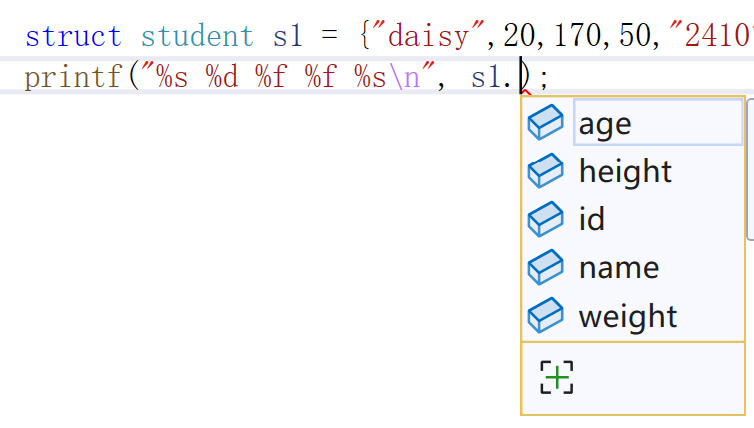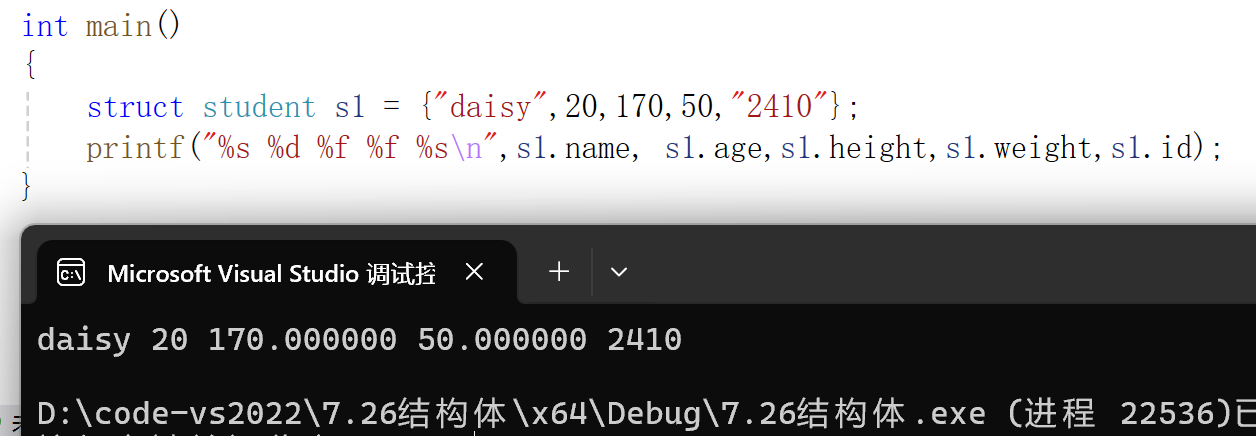【C语言】结构体详解
文章目录
- 一、结构体的基本概念
- 1.1结构体的声明
- 1.2 结构体变量的创建
- 1.2.1 在结构体声明同时创建
- 1.2.2 在main函数中创建
- 1.3 结构体变量的初始化
- 1.3.1 按照默认顺序
- 1.3.2 指定成员初始化
- 1.4 结构体成员访问
- 二、结构体的代码示例
- 1. 结构体数组
- 2. 结构体作为函数参数
- 3. 结构体嵌套
一、结构体的基本概念
C语言已经提供了内置类型,如char,short,float,double等,这些内置类型无法描述一个复杂的对象。因此C语言提供了结构体这种自定义的数据类型。它允许我们将不同类型的数据组合在一起,形成一个新的自定义数据类型。这一特性极大地增强了 C 语言处理复杂数据的能力,在实际编程中有着广泛的应用。
1.1结构体的声明
结构体使用关键字 struct 来定义
例如,想要描述一个学生:
struct student
{char name[20]; // 名字int age; //年龄double height; //身高double weight; //体重char id[16] //学号
};//分号不可以少
结构体是一些值的集合,这些值称为成员变量。结构体中的每个成员可以是不同的数据类型,如标量,数组,指针甚至是其他结构体。
1.2 结构体变量的创建
1.2.1 在结构体声明同时创建
struct student
{char name[20]; int age; double height ;double weight; char id[16]
} s1,s2;
结构体声明时,创建变量是可选选项。此时创建的s1,s2是全局变量。
1.2.2 在main函数中创建
#include <stdio.h>
struct student
{char name[20];int age;double height;double weight;char id[16]
};
int main( )
{struct student s3;struct student s4;return 0;
}
此时创建的变量是局部变量。
1.3 结构体变量的初始化
1.3.1 按照默认顺序
struct student s3 = {"daisy",20,170,50,"2410"};
如果结构体成员变量中包含结构体:
#include <stdio.h>struct S
{char c;int n;
};struct A
{struct S s;int* p;char arr[10];
};int main()
{struct A a = { {'1',1},NULL,"hhhh"};
}
1.3.2 指定成员初始化
struct student s3 = {.age = 30,.weight=60,.name="Rare",.height=180,.id="2410"};
1.4 结构体成员访问
使用操作符.可以访问结构体中的成员

例如:打印结构体成员:
#include <stdio.h>struct student
{char name[20]; // 名字int age; //年龄double height; //身高double weight; //体重char id[16]; //学号
};int main()
{struct student s1 = {"daisy",20,170,50,"2410"};printf("%s %d %f %f %s\n",s1.name, s1.age,s1.height,s1.weight,s1.id);
}

如果结构体变量是指针类型,则需要使用“->”运算符来访问成员,格式为:
结构体指针->成员名
例如:
struct Student *p = &stu1;
p->age = 19; // 等价于(*p).age = 19
二、结构体的代码示例
1. 结构体数组
结构体数组是由多个相同结构体类型的变量组成的数组。
#include <stdio.h>struct Book {char title[50];char author[30];float price;
};int main() {// 定义并初始化结构体数组struct Book books[3] = {{"C语言程序设计", "谭浩强", 39.8},{"数据结构", "严蔚敏", 45.0},{"计算机网络", "谢希仁", 42.5}};// 遍历结构体数组并输出信息for (int i = 0; i < 3; i++) {printf("第%d本书:\n", i + 1);printf("书名:%s\n", books[i].title);printf("作者:%s\n", books[i].author);printf("价格:%.1f\n\n", books[i].price);}return 0;
}
运行结果:
第1本书:
书名:C语言程序设计
作者:谭浩强
价格:39.8第2本书:
书名:数据结构
作者:严蔚敏
价格:45.0第3本书:
书名:计算机网络
作者:谢希仁
价格:42.5
2. 结构体作为函数参数
结构体可以作为函数的参数进行传递,既可以传递结构体变量本身(值传递),也可以传递结构体指针(地址传递)。
- 值传递:函数接收的是结构体变量的一个副本,在函数内部对结构体成员的修改不会影响原变量。
#include <stdio.h>struct Point {int x;int y;
};// 值传递结构体参数
void printPoint(struct Point p) {printf("点的坐标:(%d, %d)\n", p.x, p.y);p.x = 10; // 修改副本的成员,不影响原变量p.y = 20;
}int main() {struct Point p = {3, 4};printPoint(p);printf("原变量坐标:(%d, %d)\n", p.x, p.y); // 原变量未被修改return 0;
}
运行结果:
点的坐标:(3, 4)
原变量坐标:(3, 4)
- 地址传递:函数接收的是结构体变量的地址,通过指针可以访问和修改原结构体变量的成员。
#include <stdio.h>struct Point {int x;int y;
};// 地址传递结构体参数
void modifyPoint(struct Point *p) {p->x = 10; // 修改原变量的成员p->y = 20;
}int main() {struct Point p = {3, 4};modifyPoint(&p);printf("修改后坐标:(%d, %d)\n", p.x, p.y); // 原变量被修改return 0;
}
运行结果:
修改后坐标:(10, 20)
3. 结构体嵌套
结构体的成员可以是另一个结构体,这就是结构体的嵌套。
#include <stdio.h>// 定义日期结构体
struct Date {int year;int month;int day;
};// 定义学生结构体,其中包含Date类型的成员
struct Student {char name[20];struct Date birthday;float score;
};int main() {// 初始化嵌套结构体变量struct Student stu = {"Bob",{2003, 5, 15},92.0};// 访问嵌套结构体的成员printf("姓名:%s\n", stu.name);printf("生日:%d年%d月%d日\n", stu.birthday.year, stu.birthday.month, stu.birthday.day);printf("成绩:%.1f\n", stu.score);return 0;
}
运行结果:
姓名:Bob
生日:2003年5月15日
成绩:92.0
